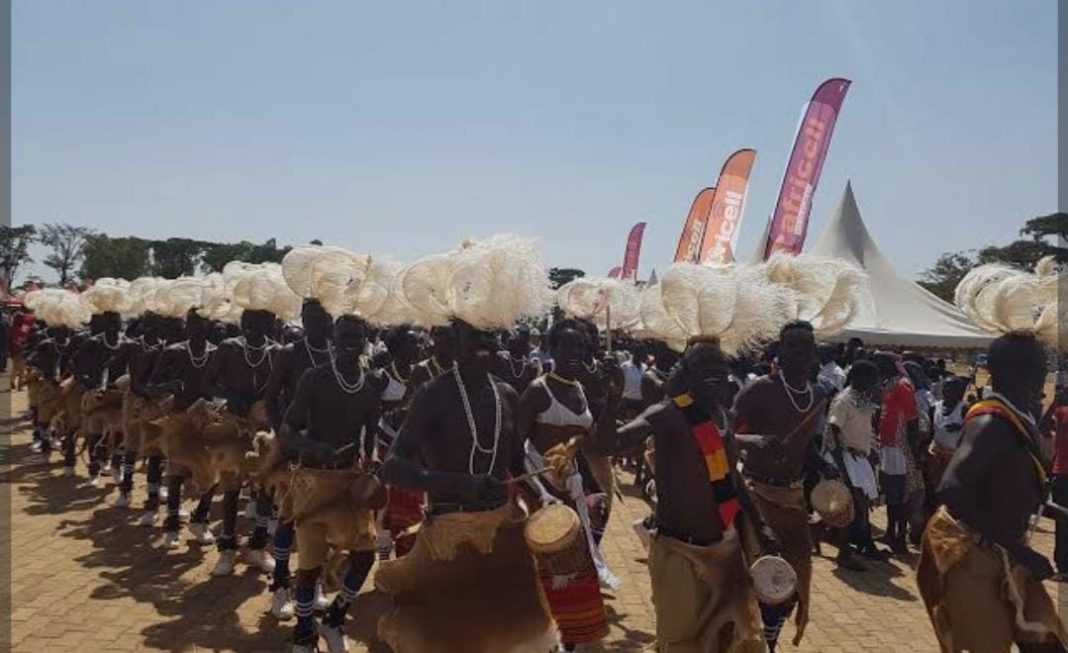By James Okoth
They came not as politicians, not as diplomats, but as brothers.
Sixteen elders from the Lamogi Chiefdom of northern Uganda crossed into Kenya this November, carrying with them ancient symbols of unity: a royal spear, a whip of truth, a gourd of blessing and a winnowing tray as gifts not of gold, but of kinship.
Their mission was sacred, to pay homage to Raila Amolo Odinga, the son of East Africa whose life, like the River Nile that binds their lands, flowed beyond political boundaries into the deep waters of shared ancestry and cultural unity.
The Journey of the Lamogi
Led by Rwot Otinga Atuka Ottoyai II, the Lamogi delegation travelled from Amuru District in northern Uganda to Bondo, Siaya County, where the Odinga family was observing the post-burial cultural rites for the departed statesman.
In their tradition, chiefs do not attend immediate funerals; the spirit must first rest. Their visit, a month after Raila’s passing, was therefore a gesture steeped in custom, reverence and historical continuity.
At Kang’o ka Jaramogi, they were received with dance and tears, not of mourning, but of reunion. The elders spoke of bloodlines that predate borders, of migrations that birthed both the Luo of Kenya and the Lamogi of Uganda, and of a shared identity that Raila had long championed through his Pan-African ideals and his unwavering call for unity beyond tribe and territory.
The Man Who Dreamed Beyond Nations
Raila Odinga’s politics were often read in the language of power, but his philosophy was always one of peoplehood.
He spoke of a continent that must remember itself — that Africa’s strength lay not in the flags that divided it, but in the cultures that connected it.
For the Luo, the Lamogi, the Acholi and many other Nilotic communities scattered across the East African plain, Raila embodied the spirit of a cultural custodian, a modern-day elder who understood that identity is both political and spiritual.
When the Lamogi delegation laid their gifts before his resting place, they were not only honouring a leader; they were affirming the oneness of a people fractured by colonial lines but bound by language, rhythm and memory.
Symbols That Speak Across Time
Each item the Lamogi elders brought carried meaning older than nations:
The Spear (Tong) represents defence, courage and continuity of lineage.
The Whip (Odo Wino) reminds that truth must always lead power.
The Gourd (Abiya) is the vessel of life and blessing, signifying abundance and renewal.
The Winnowing Tray (Ayang) symbolises the wisdom to separate good from evil, integrity from corruption.
In offering these to the Odinga family, the elders were, in essence, returning what Raila himself had stood for: justice, truth, resilience and the renewal of a people’s dignity.
A Legacy Beyond Borders
The Lamogi visit is not merely ceremonial but cultural diplomacy in its purest form and a conversation between the living and the departed, between Uganda and Kenya, between the past and the future.
It reminds East Africa that before there was a border, there was belonging. Before there were nations, there were narratives of families that fished from the same river, danced to the same drums and mourned their dead under the same moon.
Raila Odinga, through his vision of integration and unity, lived out this truth. He saw the East African Community not as a bureaucratic bloc, but as a return to an older wholeness where shared heritage became the foundation of shared progress.
The Spirit of Return
As the Lamogi delegation departed Bondo, the air was thick with a sense of closure and renewal.
One elder was heard saying, “We came to mourn, but we found our own reflection.”
In that statement lies the profound cultural significance of the visit: it was not just about Raila’s death, but about the reawakening of East Africa’s ancestral conscience.
The Lamogi visit stands as a timeless reminder that borders may divide land, but they can never divide lineage and in that truth, Raila’s spirit, and the spirit of the Lamogi, continues to live on.




